11 Ecommerce Email Marketing Metrics You Must Track in 2025

Suppose you’re running an online store, and you’ve just sent out a new email campaign for your latest products. You carefully wrote the message, created attractive visuals, and hit send with high hopes. A week later, you’re excited to see the results. But instead of clear answers, you find yourself lost in a sea of numbers, unsure which ones matter and what they mean for your business.
This is a common situation for many online store owners. Understanding email marketing metrics can feel confusing, but knowing these numbers is crucial for turning your email campaigns into powerful sales tools.
In 2025, tracking the right metrics will be the difference between guessing and knowing what your customers want, and ultimately, the success of your marketing efforts. That’s why, in this blog, I have listed 11 key email marketing metrics you need to track this year to turn data into action and connect with your customers like never before.
So, let’s get started with the basics!👇🏻
What are email marketing metrics exactly?
Ever wonder if anyone’s actually opening those emails you spend time crafting? Email marketing metrics are like little clues into your subscribers’ minds, showing you if your emails are catching attention, getting clicks, and turning those clicks into actions you care about, like sales or website visits.
By tracking these numbers, you can see what works for your audience and improve your email strategy for better results. It’s all about ensuring your emails are making an impact, enhancing sales engagement, and not getting lost in inboxes.
Why tracking email metrics is important for your ecommerce business marketing
Tracking email metrics is like having a roadmap that guides you in optimizing your email marketing strategy. So, here is why it’s important for your business:
Measure campaign effectiveness
Metrics like open rates, click-through rates, and conversion rates tell you if your emails are resonating with your audience and driving them to take action.
Boost ROI
Email marketing offers a high ROI, but tracking metrics help ensure you’re getting the most out of your efforts. You can identify areas to reduce costs or increase conversions.
Improve audience engagement
By analyzing metrics, you can identify areas for improvement. For instance, low open rates might indicate a need for more compelling subject lines or better segmentation.
Optimize content and design
Metrics can reveal what kind of content and design elements work best for your audience. This helps you tailor future campaigns for better engagement.
Gain customer insights
Metrics provide valuable insights into subscriber behavior and preferences. This allows you to personalize your email marketing and cater to their specific interests.
You can also use the best ecommerce marketing tools to get the metrics you need, one such easy-to-use and top-rated tool is Zixflow.
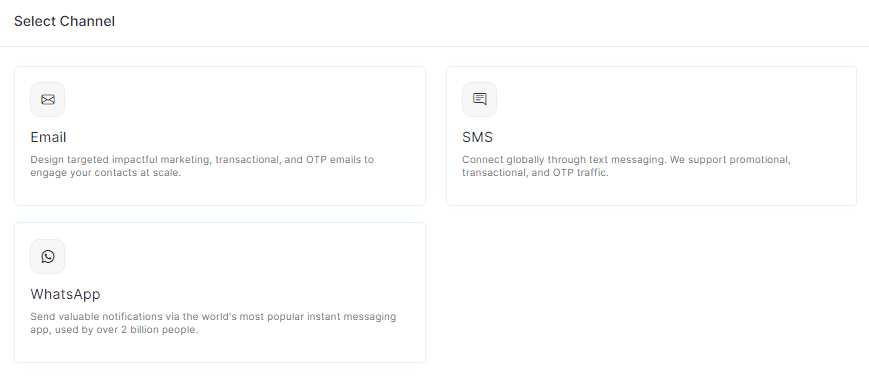
Zixflow is an all-in-one platform designed to effectively manage, engage, and retain customers. It’s a user-friendly and AI-powered solution that goes beyond traditional CRM by prioritizing automation, customization, and streamlined workflow.
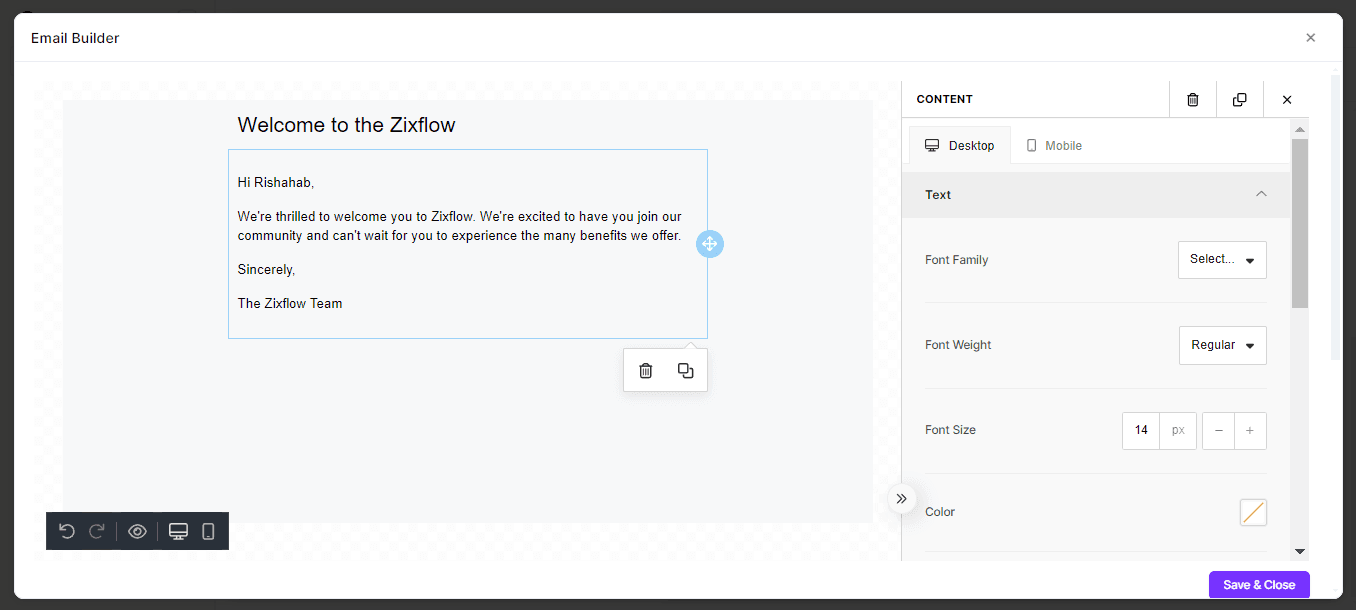
Zixflow offers you a drag-and-drop builder for designing emails or pre-made templates to get you started quickly. You can build targeted email lists by segmenting your audience based on demographics or interests, allowing for more relevant campaigns.
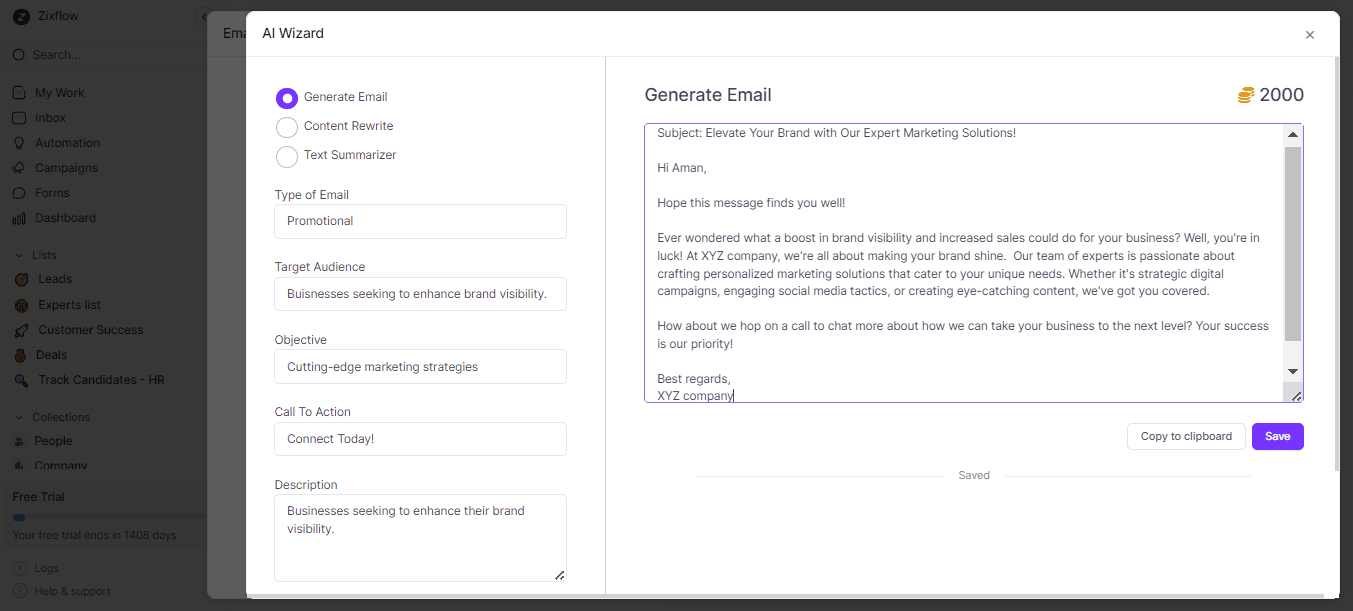
Not only that! With Zixflow’sAI Wizard, you can generate emails, rewrite content, and summarize text quickly. Just provide the necessary details like the type of email, target audience, call to action, objective, and description idea, and it will generate a ready-to-send email for you.
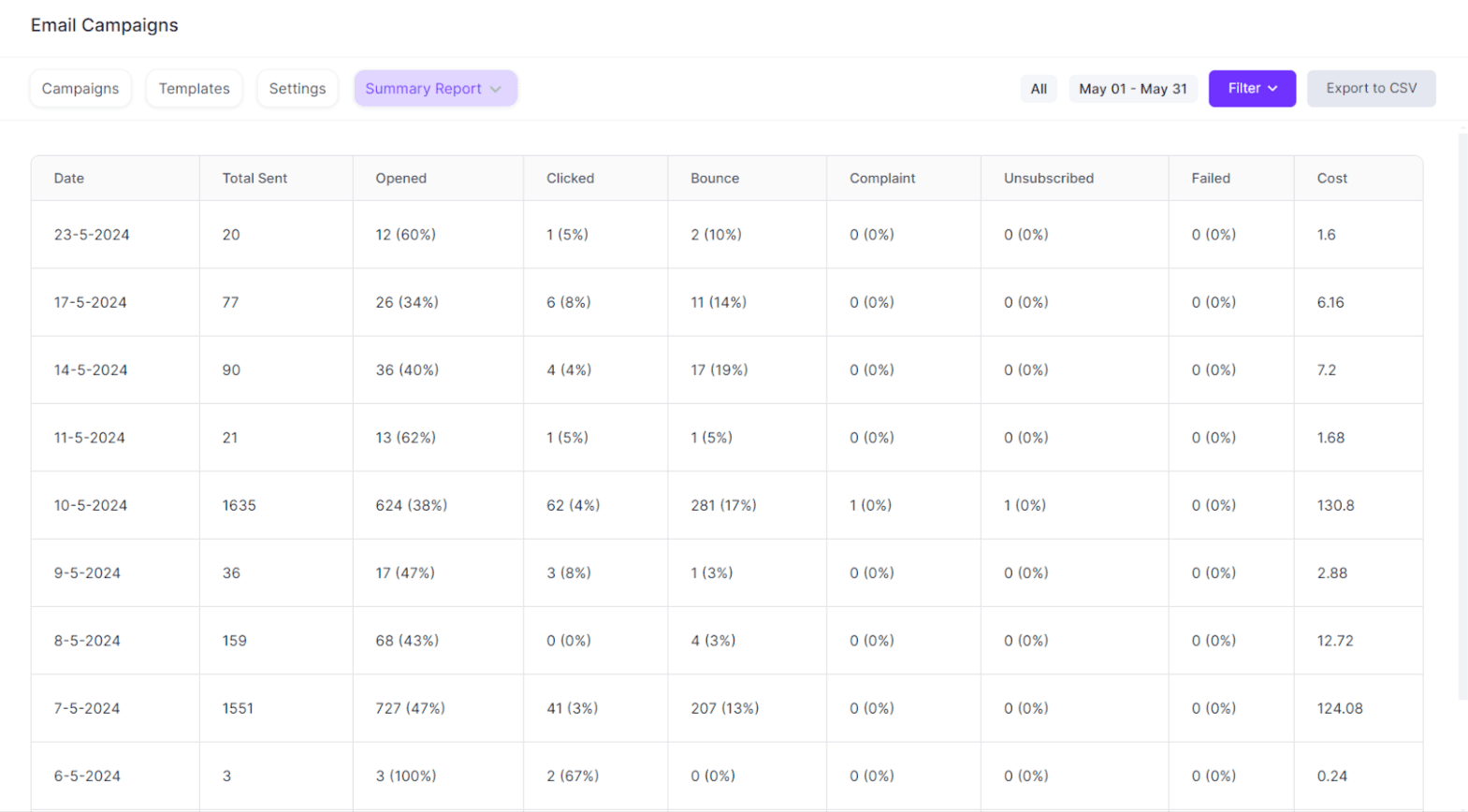
👉🏻 And here is the best part! Zixflow offers a comprehensive summary report feature within its email campaigns, enabling you to monitor key performance metrics effectively. This feature provides exact data on opened emails, click-through rates, bounces, complaints, unsubscribes, failed deliveries, and campaign costs.
By presenting these metrics in a clear and concise manner, Zixflow helps you make informed decisions to optimize your email marketing strategies, improve engagement, and maximize ROI.
Also, the summary report helps you identify total emails sent and their respective dates, further enhancing overall campaign effectiveness and ensuring you achieve your marketing goals with precision. You can even watch a quick video on how Zixflow’s email campaign works.
Now, let’s come to the point.🤩👇🏻
11 ecommerce email marketing metrics you should track
Tracking email marketing metrics is crucial for understanding how well your email campaigns are performing and achieving your desired outcomes. That’s why, below I have mentioned 11 ecommerce email marketing metrics you can track.
Conversion rate
For your ecommerce business email marketing is a powerful tool to boost your sales process and connect with your customers. But with so many emails filling up inboxes every day, it’s important to see how well your campaigns are convincing subscribers to buy. That’s where the conversion rate comes in.
The conversion rate shows the percentage of customers who do something you want after reading your email. This could be making a purchase, adding something to their cart, looking at a specific product, or signing up for a deal.
What is considered a “good” conversion rate depends on things like what you sell and who you’re selling to. But here are some average numbers to give you an idea:
- According to Klaviyo’s 2025 email marketing benchmarks report, the average conversion rate for all businesses is about 0.09%.
- For online shops, conversion rates usually fall between under 2% and 5%.
If you’re not sure how to figure out your conversion rate, it’s not hard. Here’s how to do it: Conversion Rate = (Number of Conversions / Number of Emails Sent)*100.
For example, if you send an email to 1,000 customers and it leads to 20 sales, your conversion rate would be: Conversion rate = (20 / 1000)*100 = 2%.
Open Rate
The open rate is a very important metric for your ecommerce business’s email marketing. It tells you the percentage of customers who actually open your emails. This helps you see how effective your email campaigns are in reaching your intended audience.
The good part is they often have high open rates compared to other industries. Convertcart states that ecommerce emails typically have an average open rate of about 36.59%.
The formula for calculating the open rate is simple: divide the number of emails opened by the total number of emails sent and then multiply by 100 to get a percentage.
For example, if you send out 1000 emails and 350 of them are opened, your open rate would be (350 / 1000) x 100 = 35%.
Click-through Rate (CTR)
Click-through rate (CTR) is still important for seeing how well your e-commerce email marketing is doing in 2025. It shows what percentage of customers who got your email clicked on a link in it. CTR tells you a few key things about your email marketing:
- A high CTR means your customers like your email and are interested in it.
- CTR helps you see if your email content matches what your audience likes. A low CTR might mean you need to improve your content.
What’s considered a good CTR varies depending on things like your business sector and how you’re sending your emails. As per Campaign Monitor, an ideal email click rate falls within the range of 2% to 5%.
Calculating your CTR is simple: CTR = (Number of Clicks / Number of Emails Delivered)*100.
For example, if you send 1,000 emails and get 50 clicks, your CTR would be 5%.
Spam Complaint Rate
Email marketing is truly important for your ecommerce business’s marketing and to engage your customers. But if your emails end up in the spam folder, it can really hurt your efforts. That’s why watching your spam complaint rate is so important.
The spam complaint rate shows the percentage of your email subscribers who mark your emails as spam. You calculate it by dividing the number of spam complaints by the total number of emails delivered.
For example, if you send 10,000 emails and get 10 complaints, your spam complaint rate is 0.1% (10 complaints / 10,000 emails).
A good spam complaint rate is below 0.1%, which means less than 1 complaint per 1,000 emails sent. If your rate is higher, it suggests there might be problems with your email strategy and it can harm your sender’s reputation.
Unsubscribe Rate
The unsubscribe rate shows the percentage of customers who choose to stop receiving your ecommerce email marketing messages. This is an important metric because it indicates how well your emails are connecting with your customers.
According to GetResponse, an unsubscribe rate below 0.5% is normal. However, it’s important to consider how mature your email list is.
New lists tend to have higher unsubscribe rates as customers decide if they’re interested. Your goal should be to keep the rate low after your list stabilizes to ease your sales process..
However, most email marketing platforms will do this for you, but here's how you can calculate it:
- Divide the number of unsubscribed users by the number of emails delivered.
- Multiply that result by 100 to get a percentage.
For example, if you delivered 1,000 emails and 5 people unsubscribed, your unsubscribe rate would be (5 / 1,000)*100 = 0.5%.
Get detailed analytics of email marketing to level up your business
With Zixflow’s detailed analytics you can track your email marketing campaigns to make informed decisions
Sign UpForwarding and Sharing Rate
The forward and sharing rate is another key metric in ecommerce email marketing that measures recipient engagement and content effectiveness. It shows how many subscribers find your email content interesting enough to share with others. Here’s why this metric deserves your attention:
- A high forward rate indicates your emails resonate with your audience. They find the content valuable and relevant enough to share with friends or colleagues.
- When subscribers share your emails, it exposes your brand to new potential customers without additional marketing spend.
- Analyzing emails with high forward rates helps identify the type of content that resonates with your audience. You can then use this knowledge to inform future campaigns.
Generally, a good forward rate falls between 0.5% and 2% mentioned by AgencyAnalytics. This might seem low, but keep in mind that customers are selective about what they share. Even a small percentage indicates your content is engaging and reaching a wider audience.
Calculating the forward rate is straightforward:
- Divide the number of times click on the forward & share button by the total number of emails delivered.e
- Multiply the result by 100 to express it as a percentage.
For example, if you send an email to 1,000 subscribers and receive 15 forwards, your forward rate would be: (15 forwards / 1,000 delivered emails)*100 = 1.5%.
Bounce Rate
For your ecommerce business, email marketing is important for you to drive sales and engagement. However, like any marketing strategy such as outbound sales strategies, measuring its effectiveness is crucial. One key metric to track in 2025 is the bounce rate.
The bounce rate in email marketing refers to the percentage of emails that fail to reach a recipient’s inbox. When an email bounces, you receive a notification (Non-Delivery Report or NDR) indicating the delivery issue.
A high bounce rate can negatively impact your ecommerce email marketing efforts in several ways:
- Bounced emails mean your message isn't reaching your target audience, hindering engagement.
- Email providers may flag accounts with high bounce rates as spam, affecting the deliverability of future campaigns.
- Time and money spent crafting compelling emails are wasted if they bounce.
- The ideal bounce rate of 40% or below is considered healthy.
You can calculate your bounce rate easily. Here’s the formula: Bounce Rate = (Number of Bounced Emails / Number of Emails Sent)*100.
For example, if you send 10,000 emails and receive 200 bouncebacks, your bounce rate is 2%.
Click-to-Open Rate (CTOR)
Simply sending out emails isn’t enough, you need to track key metrics to understand how your campaigns are performing and find areas for improvement. One important metric to monitor is the Click-to-Open Rate (CTOR).
CTOR is the percentage of email recipients who clicked on a link within your email after opening it. It measures how effective your email is at capturing attention and encouraging subscribers to explore your content further.
The ideal CTOR can depend on the industry, email content, and your subscriber list. However, as a general benchmark accordion to Campaign Monitor, a CTOR between 6% and 17% is considered healthy for e-commerce emails. You can simply calculate CTOR using this formula:
CTOR = (Unique Clicks / Unique Opens) x 100
- Unique Clicks: The number of times a unique subscriber clicks on a link in your email.
- Unique Opens: The number of times your email is opened by unique subscribers.
For example, if you send an email to 1,000 subscribers, and 200 people open it, with 25 of them clicking on a link, your CTOR would be: CTOR = (25 / 200)*100 = 12.5%
List Growth Rate
For your ecommerce business, having a growing email list is crucial for successful marketing campaigns. This is where the List Growth Rate (LGR) comes in as a vital metric that shows how quickly your email list is expanding.
LGR measures the percentage increase in your email subscribers over a specific period. It tells you how well you're attracting new customers and building your audience. A positive LGR means your list is growing, while a negative one means you’re losing subscribers.
There isn’t a perfect LGR number, as it can vary depending on your industry, target audience, and marketing tactics. However, the average LGR for email marketers is around 2.5%, according to the Data & Marketing Association.
The formula to calculate your LGR is simple: LGR = ((Number of New Subscribers) / (Previous List Size))*100%.
For example, if you had 1,000 subscribers on May 1st and gained 50 new subscribers by May 31st, your LGR for May would be: LGR = (50 / 1000)*100% = 5%.
Return on Investment (ROI)
Another key metric to track is Return on Investment (ROI) to measure how effective your ecommerce email marketing efforts are. It shows how much revenue you earn for every dollar spent on your email marketing campaigns.
On average, businesses make between $36 and $42 for every $1 spent on email marketing. However, what counts as a “good” ROI can differ based on your business size and goals.
Here’s a simple formula to calculate your ROI: ROI = (Revenue from email campaigns - Cost of email marketing) / Cost of email marketing* 100%.
Are you looking to boost click-through rates in your email marketing?
Utilize Zixflow to create click-worthy emails in seconds with AI-Wizard
Get Started NowDisengagement Rate
The disengagement rate is an important metric to see how well your ecommerce email marketing campaigns are working. It shows you how many subscribers are losing interest in your emails by unsubscribing or marking them as spam. As per Campaign Monitor, a disengagement rate below 0.17% is average for e-commerce email marketing.
Here’s the formula you can use to figure out your disengagement rate: Disengagement Rate = (Unsubscribes + Spam Complaints) / Total Emails Sent*100%.
For example, if you sent out 10,000 emails in a month and got 15 unsubscribes and 5 spam complaints, your disengagement rate would be: Disengagement Rate = (15 + 5) / 10,000*100% = 0.2%.
By keeping an eye on your disengagement rate regularly, you can spot trends and adjust your email marketing strategies to do better.
Level up your ecommerce email marketing by tracking the given metrics
By now, you have a proper understanding of the essential ecommerce email marketing metrics to track. Monitoring these metrics gives you valuable insights into your campaigns, helping you understand subscriber behavior, identify areas for improvement, and boost sales efficiency and revenue for your online store.
Effective email marketing isn’t just about open rates. By looking deeper into the metrics mentioned, you can better assess your email marketing’s real impact. Use this data to make smart decisions, improve your campaigns, connect better with your audience, and build customer loyalty.
But, to make this data-driven approach easier, consider using a platform like Zixflow. It simplifies the process with AI-Wizard for email copy, automation workflows to free up your time, and in-depth analytics to track your progress.
Plus, Zixflow’s unified inbox keeps all your customer interactions in one place, allowing you to respond to inquiries and nurture leads seamlessly.
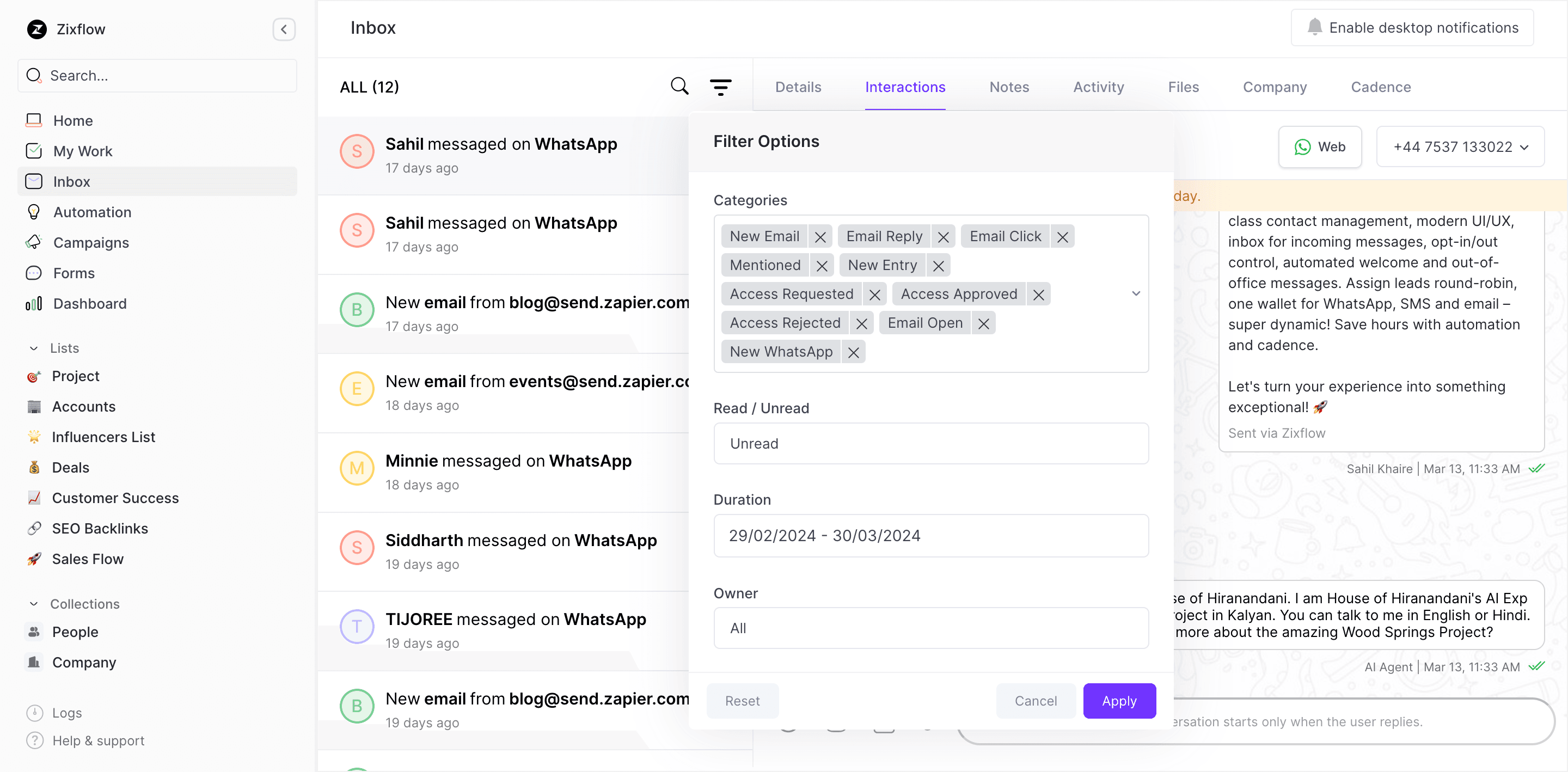
Try Zixflow for free focus on building your customer relationships and growing your business while Zixflow handles the repetitive work to streamline your communication.
